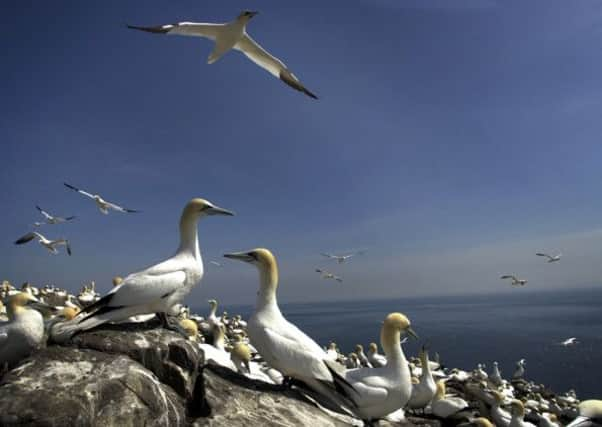Scotland’s gannet population soars across country


The survey of the spectacular seabird in the north-west coast of the country has discovered that numbers have increased rapidly over the last decade, particularly at Sule Skerry, a remote, tiny island in the wild Atlantic 40 miles west of Orkney, which has recorded a 47 per cent rise per year.
The news comes just weeks after another study found the Bass Rock in East Lothian took over from St Kilda as the world’s largest gannet colony with a population of 75,000.
Advertisement
Hide AdAdvertisement
Hide AdThe gannet population estimates for the various colonies in 2013 are 60,290 on St Kilda, 11,230 on Sula Sgeir, 5,280 on the Flannan Islands, 4,550 on Sule Stack, and 1,870 on Sule Skerry.
The SNH-commissioned survey found that gannets nesting at Sule Skerry increased at a rate of more than 47 per cent per year. On the Flannan Islands, the growth was 7.5 per cent per year. Numbers changed very little on St Kilda and Sule Stack.
Eileen Stuart, SNH’s head of policy and advice, said: “Scotland has internationally important populations of seabirds, and gannets in particular, so it’s vital that we monitor how they’re faring. The survey is especially good news as gannets are, like many seabirds, of conservation concern.”
Gannets are commonly seen around the Scottish coast throughout the spring, summer and autumn. Breeding colonies such as Bass Rock in East Lothian and Troup Head in Aberdeenshire are great places to watch them.
Gannets are Scotland’s largest seabird, weighing between 2.5 to 3.5kg, with nearly a six-foot wingspan.
They migrate to the west coast of Africa, and sometimes further, in the winter. They only lay one egg and pairs typically mate for several seasons, if not for life.
The good health of gannets across Scotland may be explained by their foraging behaviour.
They can fly for great distances in search of food, and are able to take a wide range of prey species – features which may make them more resistant to changes in the marine environment compared with other birds. They also usually nest at sites which have few predators, have produced lots of chicks over the past decade, and have high survival rates.
Advertisement
Hide AdAdvertisement
Hide AdBoth Sule Skerry and the Flannan Islands have plenty of unused but suitable nesting habitat, and this may explain why the number of gannets in these particular colonies has increased.
This contrasts to the stable numbers on Sule Stack, where gannets already occupy all the suitable breeding areas. This may lead to gannets establishing new colonies, as has already occurred at Sule Skerry, and may also be happening at Barra Head.
SEE ALSO
FOLLOW US
SCOTSMAN TABLET AND MOBILE APPS